Gaps in the mouth left by missing teeth are not only unsightly, but they can make it difficult to eat and speak properly. Furthermore, the surrounding teeth can also shift over time to fill in the space left by missing teeth. This can disturb both the function and look of your smile. For these reasons, many people opt to replace their missing teeth with various types of dental restorations.
One common option associated with missing teeth is dentures. Dentures are false teeth supported by a plastic base that blends in with the gums. They can be fabricated using a variety of materials, which can affect their appearance. Cosmetic dentures use specialized materials to replace missing teeth and restore function all while improving the aesthetics of your smile.
There are two main choices for cosmetic dentures: traditional or implant-supported. Traditional cosmetic dentures are removable and sit on top of the gum tissue. Implant-supported cosmetic dentures are attached to and supported by a series of dental implants that are placed inside the jawbone. Implant-supported dentures have certain benefits over traditional cosmetic dentures, however, they require a certain amount of bone mass in the jaw to be placed.
Here are three reasons why you should consider cosmetic dentures:
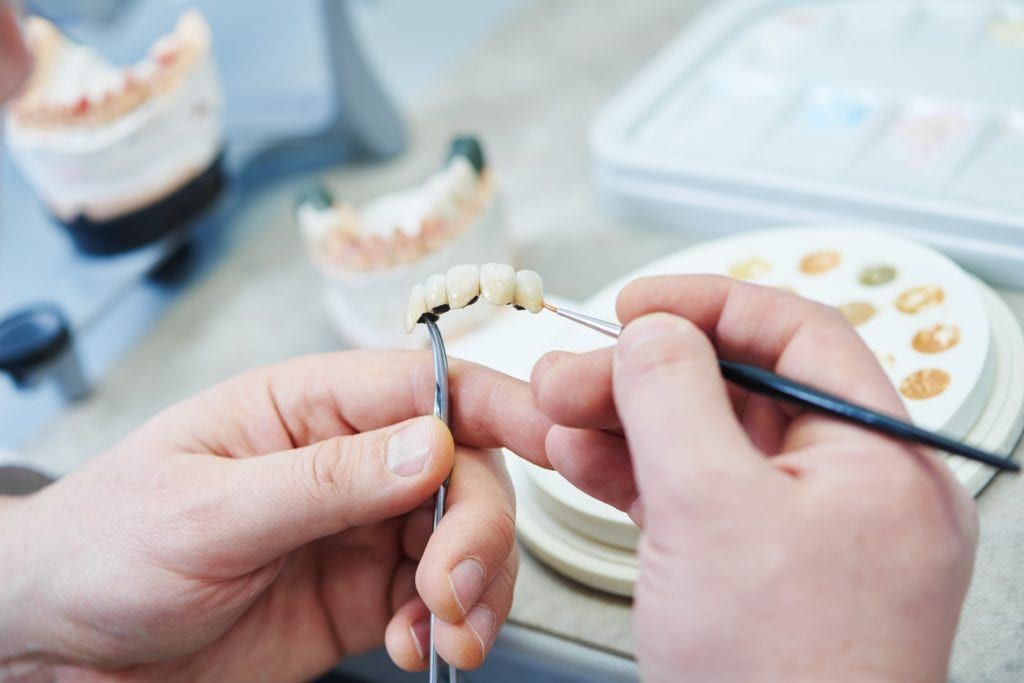

Cosmetic dentures have a slightly different appearance when compared to traditional dentures. For starters, cosmetic dentures are fabricated using high-quality materials that are visually comparable to natural teeth, resist stains, are less likely to distort, and resist wear. In most cases, traditional dentures used acrylics. While acrylics are an inexpensive, easy dental material to work with, they are prone to staining, lack a lifelike appearance, wear down quickly, and can easily warp.
Cosmetic dentures are also fabricated by highly skilled technicians that specialize in cosmetic dentistry. This means that they will pay attention to the subtleties of color, translucency, and shape that will make your smile look amazing and natural.

Implant-supported cosmetic dentures are able to preserve the jawbone and prevent bone loss. This is because the implant screws supporting the denture act as artificial tooth roots that provide the same type of stimulation as natural tooth roots. In order to maintain its bone mass, the jaw needs to have adequate stimulation from chewing and biting. Otherwise, the body will start absorbing the bone for use elsewhere in the body. This is a process called bone resorption. Bone resorption can eventually cause traditional cosmetic dentures to not fit as well, and can also cause the entire face to change shape. The fact that implant-supported cosmetic dentures preserve the jawbone is one main benefit they have over traditional cosmetic dentures.

Both types of cosmetic dentures help to restore and maintain proper function. With traditional cosmetic dentures, there may be a brief adjustment period when they are first placed. During this period, eating and speaking may seem difficult, however, once you have adapted to your new dentures things will get much easier. Once you have learned how to use your cheek and tongue muscles in coordination with your cosmetic dentures, you will be able to speak and eat properly.
Implant-supported dentures can also restore speaking and eating functions, however, they make it easier to eat just about anything, while traditional dentures may have certain dietary restrictions. Additionally, implant-supported dentures do not slip like traditional dentures.
Overall, cosmetic dentures can replace missing teeth with an aesthetically-pleasing option that allows for proper speaking and eating function. Implant-supported cosmetic dentures can even preserve bone mass. Ultimately, however, you will need to schedule a consultation with the top cosmetic dentist in Wellington to determine which option is best for you.
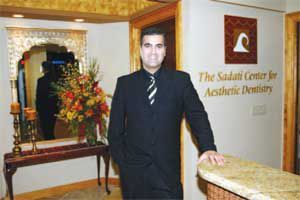
Dr. Sadati possesses extensive experience in all aspects of advanced restorative dentistry, with an emphasis in cosmetic and implant dentistry. He has attained Accredited Fellow status in the American Academy of Cosmetic Dentistry (AACD), the most rigorous, demanding credentialing process in the world. He is the only AACD Accredited Fellow in South Florida.
Out of all the various cosmetic dental treatments for replacing missing teeth, dental implants are perhaps the best restorative treatment. Over the last few years, dental implants have become increasingly popular for their aesthetic appearance, durability, longevity, and their ability to prevent bone loss. All of these characteristics can be attributed to the fact that dental implants are the only restorative method that is implanted into the jawbone.
Since they are unique to other restoration methods, there are certain things about them that are different from other types of restorative dental treatments. To determine if dental implants are right for you, it is important to consider the things that make dental implants unique. Here are five things your cosmetic dentist wants you to know before getting dental implants:

There are two different types of dental implants: endosteal and subperiosteal. Endosteal implants are most commonly used and are available in three sizes: standard, wide, and mini. Depending on the location where the dental implant is being placed, one of these three sizes will be used. Subperiosteal implants are not implanted into the jawbone and sit below the gum line on top of the jawbone. For this reason, they are not as strong as endosteal implants and are not as commonly used.
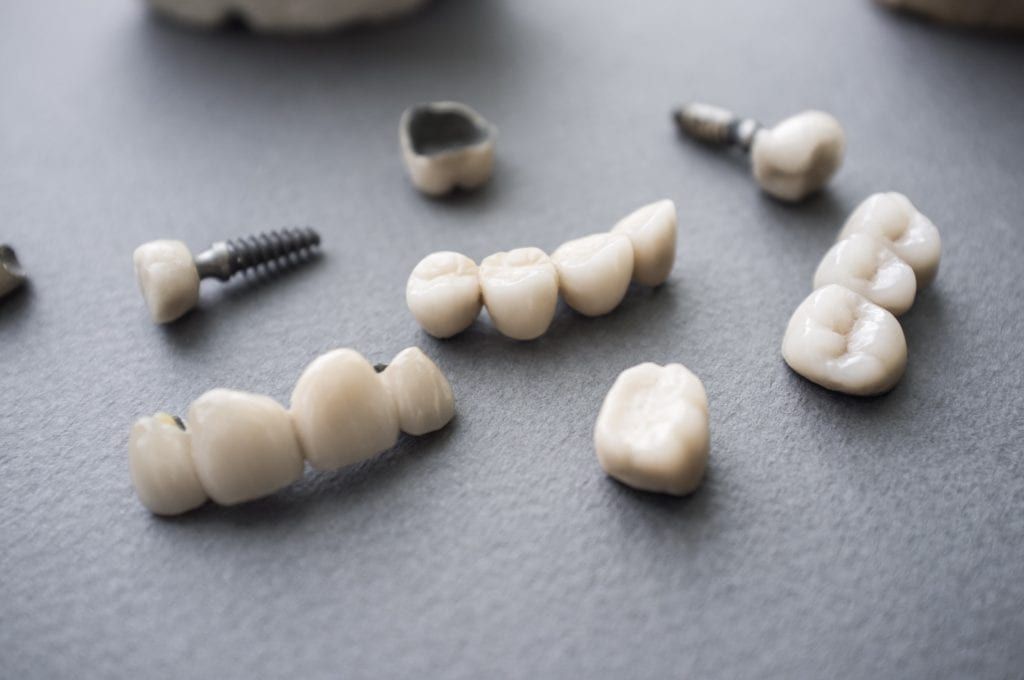

When having dental implants placed, you will need to decide what type of dental prosthesis you are planning on getting. To restore a single missing tooth, only one dental implant and a dental crown are needed. However, replacing multiple missing teeth may require multiple dental implants, as well as the choice of an implant-supported bridge or implant-supported denture.

Since dental implants are placed into the jawbone, a minor dental surgery is needed. During this procedure, a tiny incision will be made in the gums and then the empty tooth socket in the jawbone will be properly cleaned and shaped. The implant screw will then be placed with the connector attached and the gums will be sutured up around the connector so that it is visible above the gum line. In many cases, a temporary restoration will be placed while the implant heals.

While committing to post-treatment care is important with any dental treatment, it is exceptionally important for dental implants. Dental implants require the longest recovery period of any other dental restoration. This is because they must undergo a process called osseointegration, in which the implant screw fuses with the surrounding bone. Osseointegration is what gives implants their strength and durability, and must occur for treatment success. This means that for about 3-6 months patients must closely adhere to any dietary or other guidelines provided by their cosmetic dentist.
Ultimately, dental implants are different than other dental restoration methods and you should consider these five things before getting dental implants. Carefully considering these things are a good first step, however it may also be beneficial to speak with the best cosmetic dentist in your area to get more information on how these things will affect you specifically.

Dr. Sadati possesses extensive experience in all aspects of advanced restorative dentistry, with an emphasis in cosmetic and implant dentistry. He has attained Accredited Fellow status in the American Academy of Cosmetic Dentistry (AACD), the most rigorous, demanding credentialing process in the world. He is the only AACD Accredited Fellow in South Florida.
Did you know that as many as 36 million Americans have no teeth?(Source). The condition of having no teeth is known as edentulism. In most cases, the elderly are prone to edentulism because of excess plaque accumulation, gum disease, and certain medical conditions such as diabetes, hypertension, and rheumatoid arthritis. Edentulism can be extremely problematic because it can cause nutritional changes, obesity, diabetes (if the patient does not already have it), coronary heart disease, and some forms of cancer.
In cases where a patient is completely edentulous, a full mouth rehabilitation is highly recommended by dentists. full mouth rehabilitation procedures allow the dentist to restore the entire upper and lower arch of teeth. One healed from the procedure, patients generally experience almost a complete restoration of their previous function.
While many patients may hesitate at the thought of having a full mouth rehabilitation , the process is actually not as complicated as many people think. In fact, full mouth rehabilitation s use dental implants paired with an implant-supported denture and are as easy as 1-2-3! Here are the three steps of a full mouth rehabilitation :

The first step is to schedule a consultation with an experienced cosmetic dentist who has successfully performed full mouth rehabilitation s before. During the smile design consultation, you can expect your dentist to examine any existing teeth, as well as your gums. You can also expect to be asked about your treatment goals, medical history, and current medications. They will likely also take x-rays to determine how much bone mass you have, as well as a possible CBCT scan to get a look at all the underlying structures. All this information is necessary so the dentist can determine if you are a good candidate for a full mouth rehabilitation .
If you are found to be a good candidate and consent to treatment, your dentist will explain their treatment plan for you, discuss what you should expect, and answer any questions you may have. Finally, the procedure will be scheduled for a later date and you will receive instructions on how to prepare. In most cases, you will need to fast before the procedure and you may even be prescribed medication to take ahead of time.
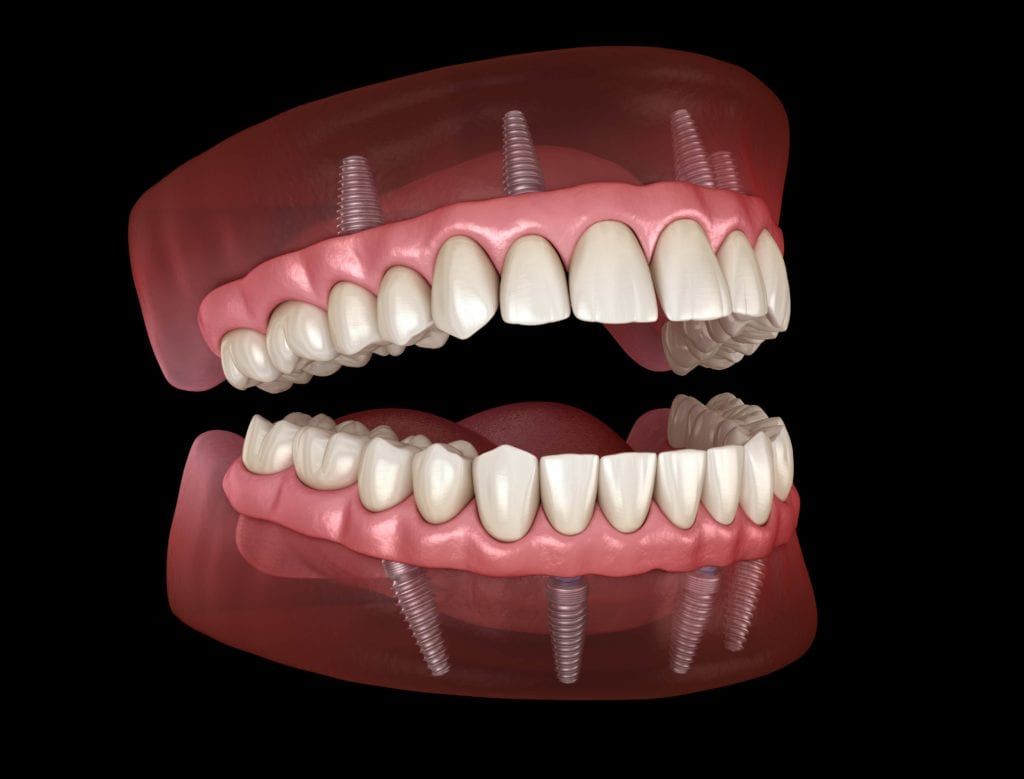
The day of your appointment, you will arrive at the designated time. Before starting the procedure, your dentist will sedate and anesthetize you to keep you comfortable and relaxed. Depending on the level of sedation used, you may not even remember your procedure. In some cases, tooth extractions may be performed to remove any remaining teeth that are decayed or damaged.
Once any remaining teeth are extracted, your dentist with place 4-6 dental implants on both the top and bottom arch. Dental implants are artificial tooth roots made from titanium screws. They are placed by making a small incision in the gums, shaping the remaining tooth socket, and inserting them into the socket. After the are placed, a connector piece is generally screwed into the implant. The gums are then sutured up over the implants and around the connector piece so that it can be seen above the gum line. This process will be repeated until all the required implants are in place. A temporary denture will then be placed.
The last and final step is recovery. You can expect to feel sore and possibly swollen for the first few days following your procedure. In most cases, patients do not report a tremendous amount of pain following their implant placement procedure and usually only require over the counter pain medications. For the first couple of weeks after having your implants placed, you will need to maintain a soft foods diet. Eventually your dentist will let you know when to start moving onto harder foods. With dental implants, it is highly important that you follow all post-operative guidelines so that the implants won’t move.
This is because dental implants must undergo a 3-6 month process called osseointegration, where the implant screws fuse with the surrounding bone. A dental implant is only considered successful when this has happened. However, exerting too much force too soon can prevent this from happening. Once your implants have completely healed, a dental impression or oral scan will be taken of your mouth and used to fabricate your permanent implant-supported dentures.
As you can see, full mouth rehabilitation s are not as complicated as you may have initially thought. The entire process is as easy as 1-2-3: consultation, treatment, recovery. Additionally, this process is made much easier by choosing the best cosmetic dentist in your area. If you are one of the 36 million Americans with edentulism, schedule a consultation with your local cosmetic dentist and get your smile back today!

Dr. Sadati possesses extensive experience in all aspects of advanced restorative dentistry, with an emphasis in cosmetic and implant dentistry. He has attained Accredited Fellow status in the American Academy of Cosmetic Dentistry (AACD), the most rigorous, demanding credentialing process in the world. He is the only AACD Accredited Fellow in South Florida.
Cosmetic dentistry can do wonders for smiles that have become less than perfect over the years. However, it’s not only the cosmetic dental procedure that can recreate your smile, but it is your cosmetic dentist that is ultimately responsible for obtaining the best results. Unfortunately, cosmetic dentists are not all cut from the same cloth and they can vary in their experience and skill sets. In order to find the best cosmetic dentist, here are seven things you should look for:
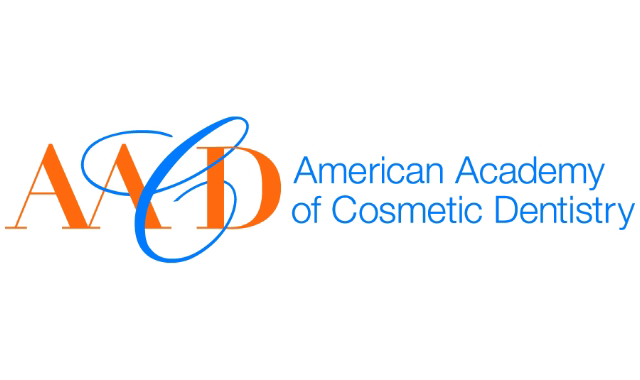

The American Academy of Cosmetic Dentistry is a professional organization dedicated to improving the field of cosmetic dentistry. Cosmetic dentists with AACD credentials have completed the rigorous process which consists of a written examination, several clinical cases, and an oral examination. This process takes years to complete and only about 350 dentists around the world have earned AACD accreditation. To learn more about AACD accreditation, see: “What are AACD Credentials and Why They’re Important”.

Many dentists claim to be cosmetic dentists, but a true cosmetic dentist devotes the majority of their time and practice to cosmetic dentistry. When researching possible cosmetic dentists, be sure to ask them how often they perform cosmetic dental treatments.

Recently, there have been many advancements in dental technology that can produce better aesthetic results faster and more comfortably than in the past. A top cosmetic dentist will provide their patients with the use of this technology to ensure the best results and patient experience. Some examples of dental technology include digital x-rays, dental lasers, and intraoral cameras or scanners.


In most cases, cosmetic dentists who are proud of their work will display several before and after pictures for potential patients to look at. This will let you examine what they are capable of to determine if you will be satisfied with the end result. While browsing through these photos, you may also come across a case similar to yours, so you can see what has been done in the past.

Many people suffer from some level of dental anxiety, so it becomes essential to find a cosmetic dentist that makes you feel comfortable during treatment. The best cosmetic dentist is one that will listen to your concerns, answer all your questions, and carefully explain their treatment approach.

Along with making you comfortable, a great cosmetic dentist will also make sure they devote enough time to your appointments and treatments. Now every dental office has its busy days, but if you are constantly feeling like you’re on an assembly line or being rushed out of the office, you may want to find another cosmetic dentist.

Unfortunately, dental insurance does not cover the cost of cosmetic dental treatments. A good cosmetic dentist realizes this and provides their patients with different payment options. Some people may avoid cosmetic dental treatment because of the cost, however affordable cosmetic dentistry is possible through monthly payments and financing plans.
When looking for the best cosmetic dentist for your needs, it is important to also look for these seven things. Cosmetic dentists who have these seven things are more likely to provide you with great, lasting results. Not all cosmetic dentists are the same, but with this guide, you can find a top cosmetic dentist in your area.

Dr. Sadati possesses extensive experience in all aspects of advanced restorative dentistry, with an emphasis in cosmetic and implant dentistry. He has attained Accredited Fellow status in the American Academy of Cosmetic Dentistry (AACD), the most rigorous, demanding credentialing process in the world. He is the only AACD Accredited Fellow in South Florida.
Did you know that 91% of American adults aged 20-64 have had at least one dental cavity? In fact, the Centers for Disease Control and Prevention has found that the percentage of adults with cavities increases with age. This means that at some point in your life you will most likely develop a dental cavity, if you haven’t already.
Most people know that cavities require dental fillings, and many people are familiar with what a dental filling is. However, not as many people are familiar with dental inlays or onlays. In fact, many people are unaware of what they are, how they work, or why they can be beneficial in certain cases. To clear up the mystery surrounding inlays and onlays, here are five facts about them:
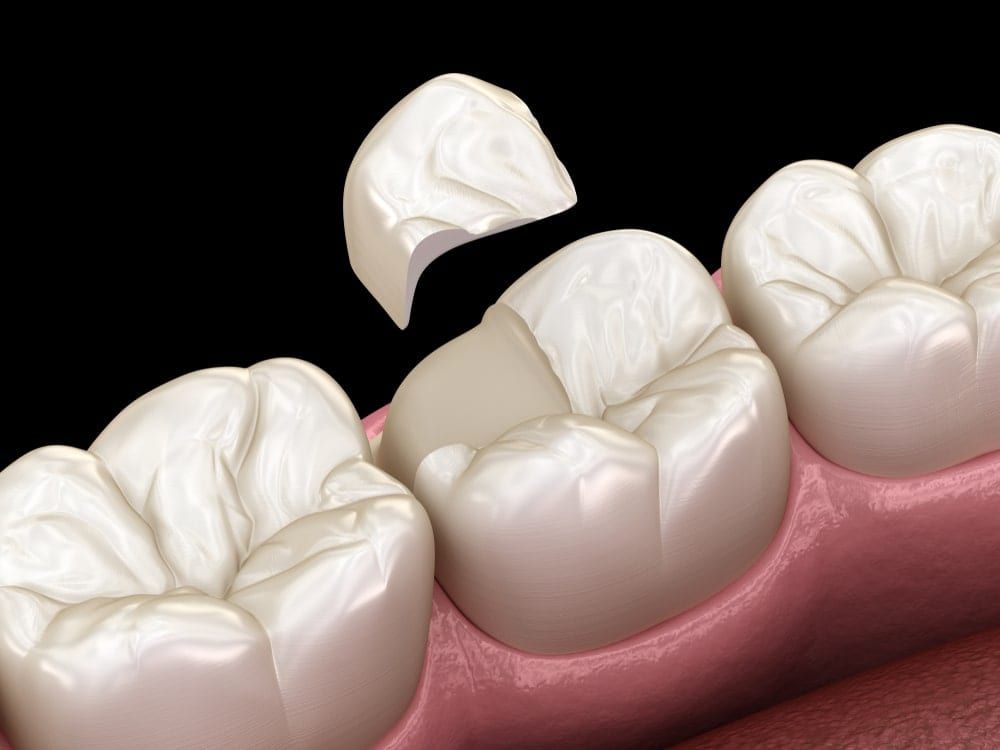

Although inlays and onlays are both applied to the chewing surface of molars, they are structurally different from one another. A dental inlay is fused to the center of the tooth over the chewing surface. A dental onlay is slightly larger and is fused over the center of the tooth and over one or more cusps, or points, of the tooth.

Another name for inlays and onlays are indirect fillings. This name is based on the fact that inlays and onlays must be fabricated in a dental lab prior to being placed in the mouth. This is one main difference between a dental filling and inlays/onlays. However, the process to place an inlay or onlay is similar to the process of placing a dental filling. The patient will be anesthetized, the decayed tissue is removed, and the restoration will be placed. With an inlay or onlay, a dental impression will need to be taken and a temporary filling will be placed until the permanent restoration can be placed.

Inlays and onlays are ideal dental restorations for cavities that are too large for a composite filling, but too small to warrant the placement of an entire dental crown. They are also used in cases where the boundary between tooth and restoration must be very fine to prevent future decay. Unlike composite fillings, dental inlays and onlays do not shrink slightly when placed and ensure the boundary remains intact.
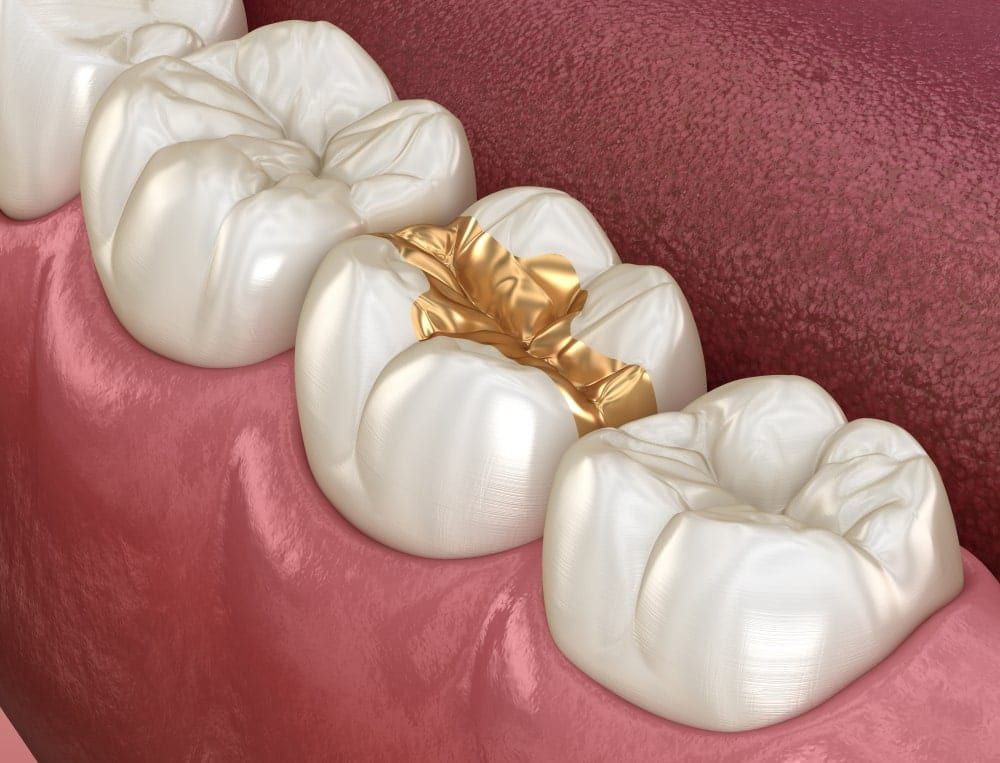

Traditionally, dental inlays and onlays were made from gold. In modern times, they can still be made from gold or other metals, as well as from ceramic and composite. Although gold was a popular choice in the past, more patients are opting for ceramic due to its strength and aesthetic appearance.

Inlays and onlays are extremely strong and durable for a variety of reasons. For starters, they preserve much of the natural tooth structure, while providing support to previously decayed areas of the tooth. Their fabrication material, as well as the fabrication process, allows them to fit seamlessly with the natural tooth structure. When ceramic is used, inlays and onlays are also able to maintain their color better than a dental filling.
Overall, dental inlays and onlays provide a specific type of dental restoration for decayed or damaged teeth that can be better than composite fillings, uses a variety of materials, and is extremely strong and durable. For these reasons, your dentist may likely recommend a dental inlay or onlay to restore your decayed tooth. To learn more, see “Inlays and Onlays”.

Dr. Sadati possesses extensive experience in all aspects of advanced restorative dentistry, with an emphasis in cosmetic and implant dentistry. He has attained Accredited Fellow status in the American Academy of Cosmetic Dentistry (AACD), the most rigorous, demanding credentialing process in the world. He is the only AACD Accredited Fellow in South Florida.
When tooth decay strikes and the dentist announces that you have a cavity that needs to be filled, you may be wondering how your smile will be affected. In the past, dental fillings may have not had the most aesthetically-pleasing look. With modern dentistry, however, unattractive dental fillings are a thing of the past.
Nowadays many dentists, especially cosmetic dentists, recommend using composite fillings to treat a tooth affected by tooth decay. But, what exactly is a composite filling? And why are composite fillings recommended? In order to answer these questions, here are five facts about composite fillings.

By filling in dental cavities, composite fillings are capable of restoring mildy decayed teeth. However, composite fillings are made from a dental material called composite resin. Composite resin is able to be matched to the natural tooth color and molded to blend with the natural tooth structure. In short, once a composite filling is applied, it will not be noticeable. Because of the way composite fillings blend with the natural teeth, they are sometimes classified as cosmetic dental treatments.
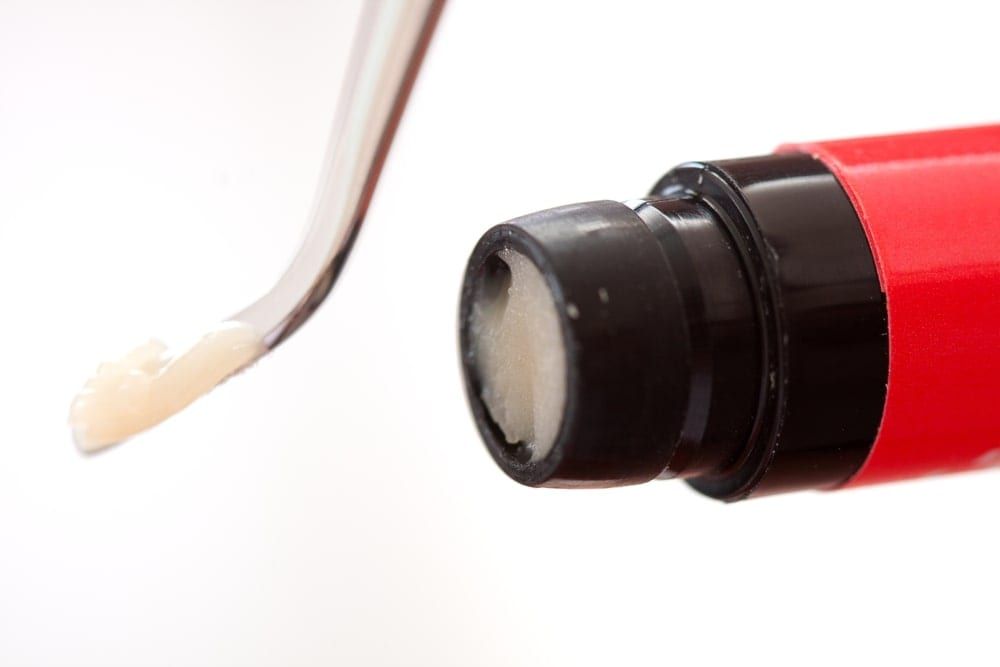

Not only are composite fillings made from a material that can blend in with the natural tooth structure, but this material also contains no metal. This means that composite fillings can safely be used on individuals with metal allergies. Additionally, it means that the teeth will maintain their color and not become discolored as a result of the corrosion caused by metal fillings. The final benefit of being metal-free is that composite fillings require less tooth preparation and preserve more of the natural tooth structure. For more information, see “Metal-Free Fillings”.

Despite the fact that composite fillings do not use metal, they are still considered extremely durable. On average, a composite filling can last about 10 years if properly cared for. Composite fillings also do not require any special care outside of a daily dental routine and avoid habits that are detrimental to the teeth, such as chewing ice.

Composite fillings are primarily used to treat tooth decay, however the composite resin material can be used for other restorative procedures. Dental composite is commonly used to build up the natural tooth structure after placing a cavity, for repairing damaged teeth, to replace worn enamel, and to fill gaps between teeth.


Composite fillings can easily be placed during a single dental appointment. This is because they are known as direct restorations, meaning that they do not require a dental laboratory for restoration fabrication. This simply means that a composite filling is completed entirely inside the patient’s mouth. When placing a composite filling, the dentist will first remove any decayed tissue and clean the affected area. Then, the tooth will be shaped in preparation for the filling. The composite resin is then placed in the filling one layer at a time. A curing light is used to harden the composite after each layer is placed. This continues until the cavity has been filled, then the final layer is shaped and polished.
Overall, there are many reasons why dentists tend to recommend composite fillings. The ease of placement, aesthetic qualities, durability, and versatility are only a few reasons. If your beautiful smile has been threatened by a cavity, composite fillings are the way to restore your tooth while preserving its natural appearance.

Dr. Sadati possesses extensive experience in all aspects of advanced restorative dentistry, with an emphasis in cosmetic and implant dentistry. He has attained Accredited Fellow status in the American Academy of Cosmetic Dentistry (AACD), the most rigorous, demanding credentialing process in the world. He is the only AACD Accredited Fellow in South Florida.
Dental hygiene is beneficial for everyone. Whether you’re trying to maintain a newly restored smile or are simply trying to prevent extra visits to the dentist, dental hygiene practices can help you. This raises the question, what is the best dental hygiene routine? In short, the best dental hygiene routine is one that uses the correct steps and techniques. Have you been using the right technique or is it time for a refresher course? Read on to find out!
The first step to any daily dental routine is, of course, brushing your teeth. Since most people have been brushing their teeth everyday for years, they often don’t question their technique. While imperfect daily brushing is overall beneficial, there are far more benefits from using the recommended brushing technique.
For starters, it is important to use the correct tools for the job. Not all toothbrushes and toothpastes are created equal. The ideal toothbrush will be long enough to reach the back of your mouth and have soft bristles. Contrary to popular belief, harder bristles will not make your teeth any cleaner. Instead, regularly brushing with a hard-bristled brush can cause gum recession and worn enamel. Once you have found an ideal toothbrush, you will also need to remember to replace it every 3-4 months or after being sick. This is important to keep excess bacteria out of your mouth. Finally, you’ll need fluoridated toothpaste that has the American Dental Association (ADA) seal of approval.
Once you have the correct tools, it is all about mastering the proper technique. According to the ADA, the proper brushing technique consists of placing your toothbrush at a 45 degree angle to the gums and using short, tooth-length strokes. To brush behind the front teeth, you will rotate the brush so that it is vertical, then use the up and down strokes. Each quadrant of your mouth should be brushed for 30 seconds, which means it should take two minutes to brush with the proper technique. You should brush your teeth at least twice a day, once in the morning and once before bed. However, additional brushing is recommended after consuming sugary or highly-pigmented foods or beverages. For more information, see the ADA’s article on “Teeth Brushing”.
In addition to brushing twice daily, you will also need to floss once a day. Again, you will want to make sure you are using the correct materials. Many people don’t realize that there are five different types of dental floss. The best dental floss is the one that works for your dental needs. Here are the five types of dental floss:

Once you have determined the best dental floss for your individual needs, the next step is to make sure you are using the proper technique. First, break off about 18 inches of floss and wind the excess around your middle fingers. Then use your thumbs and forefingers to gently guide and rub the floss between your teeth, taking special care not to snap the floss against the gum tissue. After the floss touches the gums, wrap it around the tooth in a C shape to completely clean the tooth. Finally, discard the floss after use to prevent the spread of bacteria. For more information, see the ADA’s article on “Flossing”.
Want to learn more about oral hygiene? See “Oral Hygiene, Home Care, and Professional Care”.

Dr. Sadati possesses extensive experience in all aspects of advanced restorative dentistry, with an emphasis in cosmetic and implant dentistry. He has attained Accredited Fellow status in the American Academy of Cosmetic Dentistry (AACD), the most rigorous, demanding credentialing process in the world. He is the only AACD Accredited Fellow in South Florida.
Have you ever looked in the mirror and thought, I don’t like my teeth? Perhaps your teeth look too big, too small, or too uneven. Maybe your two front teeth are longer than the rest, making your smile mismatched. Whatever the reason, there is a way to change it.
Making a visit to your Wellington cosmetic dentist is the first step. Cosmetic dentists focus on improving the aesthetics of your smile by correcting structural issues that affect the teeth. In fact, they have a variety of cosmetic dental treatment options to choose from to change the size and shape of imperfect teeth. Here are the top three cosmetic dental treatments for changing the size and shape of imperfect teeth:

Porcelain crowns are a tooth-shaped cap that fits over the visible portion of the tooth. They can be used to restore damaged teeth or decayed teeth that have been treated with a root canal. Since they fit over the natural tooth, they can also be used to improve the color, size, and shape of a tooth.

To place a dental crown, the natural tooth structure must first be altered so that it can accomodate a crown. Because of this, dental crowns are considered to be permanent or irreversible. Once the tooth is prepared, a dental impression or oral scan will be used to obtain the information necessary for the crown to be fabricated. A temporary crown will be worn until the permanent restoration has been completed. Then, the permanent dental crown will be checked for fit and adhered to the tooth.

Porcelain veneers are thin, stain-resistant shells that are adhered to the front surface of visible teeth. They are a common cosmetic dental treatment because they can easily improve the size and shape of damaged or misshapen teeth. Additionally, they can also improve the color, alignment, and spacing of teeth, making them one of the most versatile cosmetic dental treatments.
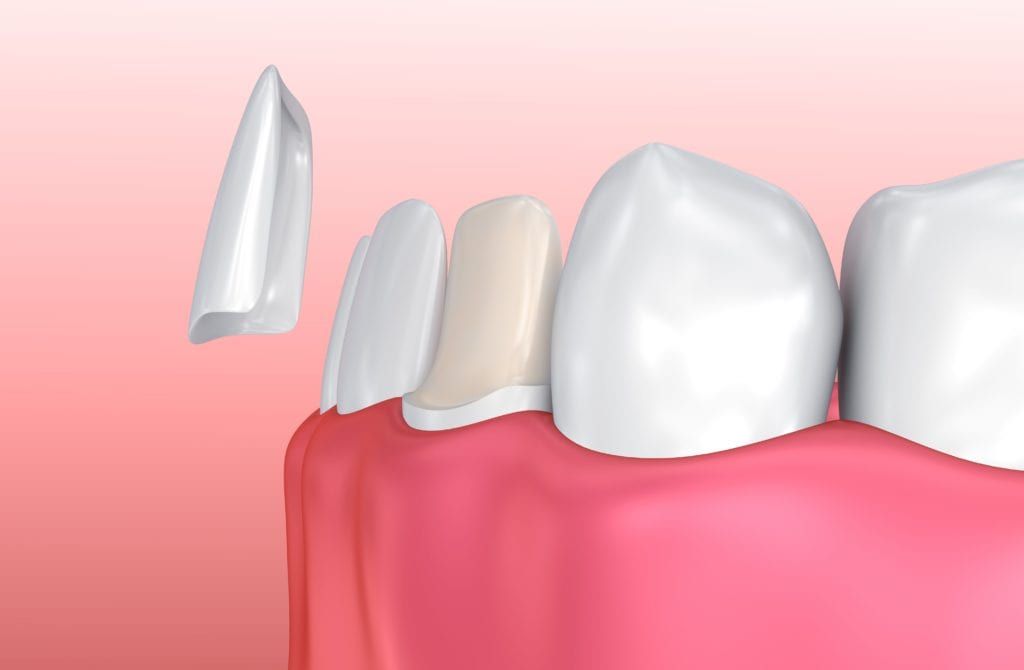
To place porcelain veneers, a tiny amount of tooth enamel must be removed so that the veneers will fit on the teeth naturally. This means that they are also considered permanent or irreversible. Once the tooth has been prepared, a dental impression or oral scan will be taken to obtain the information necessary for the veneers to be fabricated. Temporary veneers may be placed until the permanent restoration has been completed. Then, the permanent veneers will be checked for fit and adhered to the front surface of visible teeth.

Dental bonding, also known as composite bonding, uses dental composite to correct the size and shape of teeth by building on the tooth’s natural structure. Unlike porcelain crowns and veneers, dental bonding can be reversed and is not considered a permanent treatment. However, it tends to last only about half as long as crowns or veneers.
During a dental bonding procedure, the composite resin material is applied to the affected tooth in layers. Each layer must be hardened before the next layer can be placed. The layers will be placed according to the type of alterations being made to the tooth. The final layer will be properly shaped and polished so that it blends with the surrounding teeth. For more information about dental bonding, see “7 Things You Didn’t Know About Dental Bonding”.
As you can see, these three dental treatments all offer a different approach to improving the size and shape of imperfect teeth. Dental crowns will completely cover the tooth, veneers will cover the front of the tooth, and dental bonding will build upon the tooth’s natural structure. Each method has its pros and cons, so you will need to discuss these with a cosmetic dentist to decide which cosmetic dental treatment is the best for you.

Dr. Sadati possesses extensive experience in all aspects of advanced restorative dentistry, with an emphasis in cosmetic and implant dentistry. He has attained Accredited Fellow status in the American Academy of Cosmetic Dentistry (AACD), the most rigorous, demanding credentialing process in the world. He is the only AACD Accredited Fellow in South Florida.
The world of cosmetic dentistry allows us to obtain perfect, white smiles. However, some of these cosmetic dental procedures can be pricey or somewhat invasive. Many people yearn for a beautiful smile without the expense or complicated procedures. This is where dental bonding becomes the perfect cosmetic dental treatment.
Dental bonding, sometimes referred to as composite bonding, uses composite resin adhered to the tooth in order to improve its aesthetics. Dental bonding can effectively repair cracked and chipped teeth, cover up stains on discolored teeth, or close a gap between two teeth. For more information about dental bonding, see our dental bonding services page.
Beyond its basic definition, however, there are some interesting things about dental bonding that you may not know. Let’s take a deeper look into dental bonding.

Dental bonding can be used to fabricate composite veneers. Although porcelain is traditionally used for veneers, composite resin is another option that many people don’t realize. Composite resin veneers will cover the front surface of your tooth and will address the same concerns as veneers.
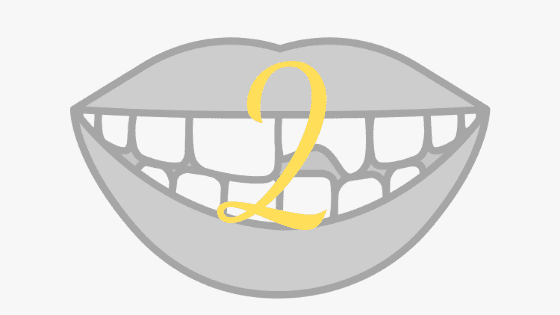
Dental bonding can be used to treat a variety of cosmetic concerns. Because of this, each treatment can be individually tailored to fit your specific cosmetic goals. Things like the size, shape, color, and thickness can all be customized when having dental bonding performed.
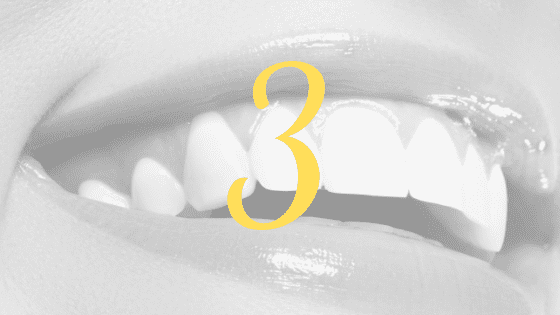
The procedure for dental bonding is so easy that it does not even require the use of dental anesthetics. First, your teeth will be cleaned and a shade guide will be used to determine the color of the bonding material. Then the composite resin will be applied to the surface of your teeth and shaped accordingly before being hardened.

Because dental bonding does not require the modification of your natural tooth structure for placement, the procedure is reversible. In fact, some people will use dental bonding to test out the appearance of veneers before committing to traditional veneers.

Dental bonding is one of the most affordable cosmetic dental treatments available. Part of this is because dental bonding can be completed entirely in our office without the need for a dental laboratory. Ultimately, the total cost of dental bonding will depend upon what you are having done.

Even though dental bonding is cheaper than other cosmetic dental options, it still is considered to be durable. If well taken care of, the effects of dental bonding can last several years. However, you will need to take care when eating hard foods and you should avoid biting down on hard objects.

Since dental bonding is only applied to the surface of your teeth without the need for enamel modification, there are no serious risks. Instead, the main downfall of dental bonding is that the bonding material may chip off if one is biting excessively hard food. Teeth grinding may also be a potential problem and can cause the bonding material to become damaged.
Overall, dental bonding is a highly versatile cosmetic dental treatment. The procedure for dental bonding is also faster, less invasive, and less complicated than other types of cosmetic dentistry. If you are looking for an easy and effective way to makeover your smile, dental bonding may be the perfect cosmetic dental treatment for you!

Dr. Sadati possesses extensive experience in all aspects of advanced restorative dentistry, with an emphasis in cosmetic and implant dentistry. He has attained Accredited Fellow status in the American Academy of Cosmetic Dentistry (AACD), the most rigorous, demanding credentialing process in the world. He is the only AACD Accredited Fellow in South Florida.
Do you have years of dental neglect or a traumatic oral injury standing in the way of a perfect smile? Is it going to take more than a dental filling or dental crown to give you that smile you’ve always dreamed of? Don’t despair any longer! Thanks to modern dental technology, you can still attain a flawless smile even if you are currently reading this with no teeth in your mouth.
For complex restorative and cosmetic dental issues, a full mouth reconstruction or full mouth rehabilitation is often recommended by Dr. Sadati. Full mouth rehabilitation works to improve the dental, skeletal, muscular, and aesthetic structures of your smile. Additionally, full mouth rehabilitation can also help you restore varying levels of chewing and speaking functions.
Sounds too good to be true, right? Luckily, full mouth restorations are very real procedures that Dr. Sadati has extensive experience performing. But, how exactly do full mouth restorations work and is it the best dental treatment for you? Let’s take a closer look.
Simply stated, a full mouth rehabilitation works by replacing multiple teeth on the top an bottom arches of your mouth. Using this procedure, missing teeth can be replaced, a correct bite can be established, and teeth can be protected from excess wear.
To restore and replace damaged, decayed, or missing teeth, a number of dental restorative procedures can be used in a full mouth rehabilitation. The type of restorative procedure used will ultimately vary based on each individual case. For example, for those with damaged teeth may require multiple dental crowns, while those with missing teeth may require dental implants instead.
In cases where there are multiple missing teeth or multiple decayed and damaged teeth, an implant-supported denture may be recommended. Implant-supported dentures used around 4-6 dental implants to support an entire dental arch of teeth. This arch can either be placed on the top, bottom, or even on both jaws, if needed.
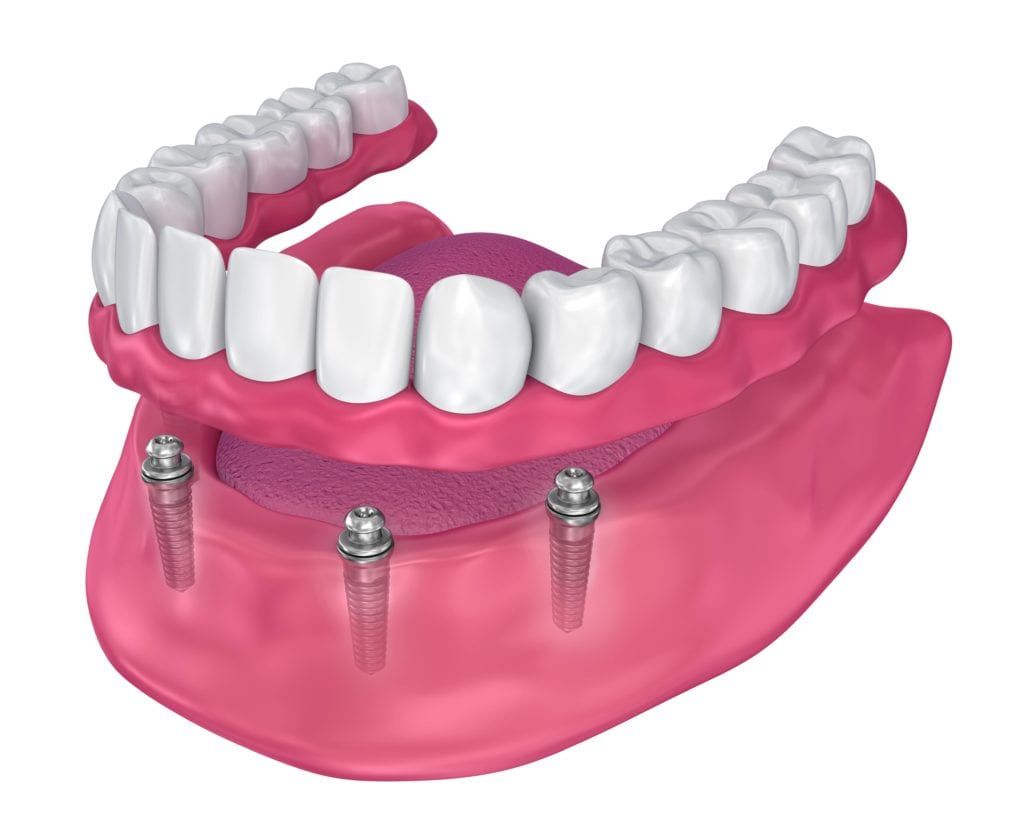
Depending on how many teeth are missing or remaining in the mouth, extractions may be necessary prior to the placement of an implant-supported denture. However, if the remaining teeth are healthy, another restoration method may be recommended instead.
In the case of missing teeth, additional reconstructive measures may be required. One common measure is a bone graft. A bone graft places bone material in areas of depleted bone tissue in order to grow new bone over time. Bone grafts are often needed in cases where teeth have been missing for over six months, because bone loss naturally begins to occur at this point. Bone grafts are commonly used in coordination with dental implants, because they help to support the implant and provide additional strength during the healing process.
If dental implants are used on the upper arch, a special type of bone graft called a sinus lift can be used. A sinus lift uses bone grafting material to build up the layer of bone that lies between the upper jaw and sinus cavity. Essentially, this procedure thickens the bone and “lifts” the sinus cavity so that the dental implant can be properly placed with damaging the sinus cavity.
While the aforementioned procedures are some of the more common procedures used for full mouth rehabilitation, there are various other procedures that may be used. These procedures can include:
While only Dr. Sadati can determine for sure if full mouth rehabilitation is the right dental treatment for your individual case, those who generally opt for full mouth rehabilitation often have:
Most patients seek full mouth rehabilitation to retain or regain chewing and speaking function when their current condition has moderately to severely impacted or threatens to impact it. In some cases, other restoration methods may have worked in the past, but are no longer effective. In other cases, a sudden traumatic event may require significant intervention to restore the mouth to is previous state.

Ultimately, because full mouth rehabilitation has such a wide scope of treatments, it can be the best dental treatment for a variety of dental issues. However, some cases may warrant other dental treatments before starting the process for a full mouth restoration. This is why a thorough dental consultation with Dr. Sadati is required to determine the best treatment plan for each individual patient.
Although we will be touching on this more in the next section, another thing you will want to realize when considering full mouth rehabilitation is that this type of procedure will require a commitment from you as well. To ensure the best treatment outcome you, as the patient will need to commit to following post-treatment directions for an allotted amount of time after your procedure or procedures. When considering if this is the best treatment for you, you will need to be realistic about your ability to commit to your healing.
Your exact expectations for your full mouth rehabilitation will vary depending on the specifics of your procedure. Once Dr. Sadati has developed a treatment plan for you, he will discuss his plan, your role, the recovery process, and answer any questions you may have.
As a general rule, full mouth rehabilitation can be moderately invasive and will require your active participation in the treatment for the best outcome. Depending on your treatment plan, multiple treatments may be required, although they may be performed all at once or over a series of months. To ensure treatment success, you will likely be given post-treatment guidelines to follow for a designated amount of time.
Most of the post treatment guidelines deal with things such as taking specific medications, keeping the treatment area clean and free from debris, temporarily adjusting your diet to soft foods, refraining from damaging behaviors, and practicing good daily oral hygiene. Additionally, you will likely be expected to attend regular dental appointments so that Dr. Sadati can monitor your progress and make treatment adjustments as necessary.
Are you ready to meet your new smile? For more information about full mouth rehabilitation, schedule a consultation with Dr. Sam S. Sadati today! Dr. Sam S. Sadati is a South Florida Cosmetic Dentist who is passionate about designing healthy, beautiful smiles for his patients. The Sadati Center for Aesthetic Dentistry proudly serves Wellington and the surrounding communities.
Research has revealed that there may be a connection between the health of your teeth and your risk of getting heart disease. While further research is going to be necessary to understand this connection, enough has been revealed to indicate that there is a definite correlation between poor oral health and an increased risk of heart disease. While regular dental care hasn’t been proven to be a direct cause of heart disease, the following evidence reveals that there is clearly some kind of connection.
This is an excellent question, and one that researchers have been testing and mulling over. While it’s clear that the two conditions show strong correlation, the direct cause of this connection has yet to be revealed. Some of the theories involved are:
Research continues to be ongoing, with smoking representing a large connection to both poor oral health and the presence of heart disease. While smoking undoubtedly accounts for increased risks of both conditions, there are still other cases that continue to show a correlation even when smoking is not involved. For now what is clear is that there is some connection between the two, making taking care of your oral health even more important than ever before.
If you want to learn more about the connection between oral health and cardiac disease then make a call to Dr. Sam S. Sadati at The Sadati Center For Aesthetic Dentistry today. When you make an appointment you’ll be receiving dental care from one of the most respected dental practitioners in Wellington, FL. Don’t let your heart be at risk because you’re oral health isn’t being seen to, pick up the phone and make an appointment with the staff of Dr. Sadati today.
Do you feel like you need to hide your smile because your teeth are crooked, chipped, or discolored? Are you looking for a way to fix these conditions that fit the realities of your life? Have you heard about veneers and wondered whether or not they’re right for you? If these apply to you it’s time to learn a bit more about this incredible restorative procedure and how it can give you the beautiful straight smile you’ve always dreamed of.
Veneers can be a fantastic way of addressing cosmetic concerns you have with your teeth, but they aren’t the perfect solutions for everyone. When trying to determine if this option will be the one that gives you the smile you need, you have to speak with your dentist after considering the following details.
Those who qualify for the restorative treatment that are veneers have the following concerns:
If you find that these conditions apply to you, then you may be able to benefit from veneers and should schedule a consultation with your dentist. Once you speak to them you’ll be able to be certain that veneers are your path to a beautiful set of teeth.
Once you’ve considered all the options and settled on veneers, it’s time to reach out to an expert in the cosmetic dentistry field. For people far and wide this means the team at the Sadati Center for Aesthetic Dentistry. Stationed in the beautiful town of Wellington, FL this office is proud to offer some of the premier cosmetic restorations available under the leadership of Dr. Sam S Sadati. For your cosmetic dentistry needs, pick up the phone and make an appointment today.
Beautiful white teeth are something that can affect every level of your life, from your social interactions all the way up to changing how successful you are at your chosen career. The level of confidence that you feel knowing that your smile isn’t discolored or yellow can make a huge difference in your life. Some people spend immense amounts of money trying to achieve that perfect smile, but if all you need is a simple whitening then there’s no need for that! We’re going a few ways you can achieve a beautiful white smile!
One of the most common whitening procedures sought by those that over-the-counter whitening won’t work for is laser whitening. Part of its popularity comes from its ability to make your teeth several shades whiter in less than an hour of treatment. Effective and quick, there’s only one drawback to using this form of treatment, and that’s what the laser is incapable of lightening porcelain crowns or veneers. Recognized as a safe procedure by the American Dental Association, it’s the perfect solution for people looking for a quick improvement in the color of their teeth.
This is an excellent option for people looking to whiten their teeth at home. Available on adhesive strips or in trays containing the peroxide-based gel this whitening method can provide incredible results for the at-home whitener. The biggest problem with using a gel whitening procedure is the multiple instructions involved and the risk of causing tooth sensitivity if it isn’t used carefully. The two most common ingredients used in whitening gels are carbamide peroxide and hydrogen peroxide. Both of these choices are equally effective at producing beautiful white teeth.
This form of whitening is reserved for people who have deep-seated discoloration that requires the tooth being whitened from the inside out. This form of whitening is only available for patients who are in need of a root canal, and therefore can only be used on teeth that have a problematic nature. This is much more thorough than some forms of bleaching, and if you already need a root canal, it will be an excellent way for you to restore a beautiful white color to your damaged (and now repaired) tooth. After that, it’s up to you to keep your newly restored teeth white and beautiful!
If you’ve been looking in the mirror while brushing your teeth and feeling self-conscious about discoloration, then it’s time to pick up the phone and get professional help getting a beautiful white smile back. Dr. Sam S Sadati helps patients in the Wellington FL area restore even the most damaged teeth to a beautiful white at the Sadati Center For Aesthetic Dentistry. Don’t hide your smile due to discoloration, make an appointment today and get a consultation that will reveal which of their whitening services will be able to restore your beautiful shining smile.
When we head off to the dentist’s office, we likely aren’t thinking about the tools they’ll use during the visit. Once we arrive and are sitting patiently in the dentist’s chair waiting for them to work on us, we may start to become curious and even a little anxious about that table of strange devices sitting nearby. If you’ve been curious what they’re all for and didn’t want to ask your hygienist or dentist about them, you can read through this handy guide and learn what these strange devices in your dentist’s office are for!
That Unnerving Whine: The Dental Drill
If there is one sound, every dental patient is familiar with it’s the shrill sound of the dental drill and the visions of terror it can bring to the mind of those who fear they may be its next subject. While the dental drill does have a distinct sound that can be unnerving, the truth of the matter is there’s nothing to fear if you need work done that involves it. A local anesthetic renders the drill loud but harmless, and while it is indeed a high speed drill its steady stream of water lets, it does its work without harming you.
Just A Small Pinch: The Dental Syringe
If you’re about to undergo a procedure involving the dental drill, or anything more intensive than a general cleaning, this device is going to be your best friend. You’ll know you’re about to be visited by it when your dentist tells you that there’s going to be “just a small pinch” and pulls out a syringe with an oddly long needle. Don’t worry though, that needle isn’t meant to go all the way into your gums; it’s just long so your dentist can carefully reach all the areas of your mouth that need anesthetic. Imagine trying to numb your molars with a traditional needle; you’d have your dentists whole hand in your mouth.
Things Are Shaping Up: Molds
If you’ve been informed that your future holds a mouth guard, cap, or crown, you’re probably going to become familiar with these. They’re typically a tray filled with a soft, sometimes unpleasant tasting, substance that will take a mold of your teeth and allow your dentist to begin preparing. If you’re fortunate, your dentist will have a flavored version to make the process more pleasant. After you bite down your dentist will remove the mold and set it aside to cure before rinsing your mouth out.
These are just some of the tools you may find in your dentist’s office, and all of them are essential to providing top-notch care for their patients. If you’re looking for a great dental experience, give Dr. Sam S Sadati a call at their office in Wellington, FL. The Sadati Center for Aesthetic Dentistry has a reputation for providing exceptional dental care in addition to its top-notch restoration and cosmetic dentistry services.
While many consider cosmetic dentistry to simply be the result of a vain desire for a more attractive smile, the truth of the matter is that restoring a beautiful smile can bring you improved confidence and create meaningful changes in your life. If you’ve been considering cosmetic dentistry and are wondering how repairing your smile could help you, read on and learn how correcting your teeth can lead to a happier you!
We know that it can be embarrassing to have a smile that you aren’t proud of, and that means you’re probably smiling less frequently and less free than you could be! “What’s the big deal about a smile?” we hear you ask? A smile isn’t just a reflection of interior happiness, the act itself can actually boost your mood and those of the people around you! That uplifting feeling when you see a bright unabashed smile isn’t just a coincidence, it’s a mental and biological consequence of smiling and seeing smiles in others. Research has shown that patients who smile less experience:
Poor Self-Esteem
Reduced levels of confidence
Isolation from avoiding social gatherings
Impacts on their love life
Depression occurs in some cases.
Cosmetic dentistry can help alleviate concerns like these and restore a powerful sense of confidence! Whether you’ve got chipped teeth, gaps, misaligned teeth, or other dental issues that impact your appearance, cosmetic surgery can restore your smile and have you feeling confident and beautiful!
If you aren’t proud of your smile and are ashamed to show it then having cosmetic dentistry performed may help improve your image of yourself and allow you to enjoy the benefits of smiling again. While exercise and determination can restore a healthy and trim body, only cosmetic dentistry can restore a beautiful smile that’s suffered from trauma or decay.
The right solution for you is largely dependent on what issues you’re experiencing with your teeth. Teeth whitening can help eliminate unsightly stains, while veneers are available to fix chipped or decayed teeth. Research has revealed that patients who get these treatments feel more confident about their appearance afterward, and benefit from higher self-esteem.
Research has also revealed that those who lose a tooth experience a form of bereavement resulting from the feeling of having aged, of their appearance having declined, and their freedom to consume the foods they love being impaired. Dental implants can restore normal life to patients who have lost one or more teeth.
If you’re experiencing any of these symptoms, it’s time to make a call to turn your life and self-confidence around. The experts at The Sadati Center for Aesthetic Dentistry have been helping patients like you tackle these concerns from their office in Wellington, FL under the expert guidance of Dr. Sam S. Sadati. Don’t let the state of your oral health impact your confidence another day, make the call to Dr. Sadati and start on your road to great psychological and physical health through cosmetic dentistry.
If you have teeth that have been damaged by decay, you are probably familiar with the traditional filling method. With this method, a dentist drills out the decay and then fills the remaining cavity with a moldable substance. In a single office appointment, this substance is molded into place and your tooth is restored. However, did you know that traditional fillings are not your only option for restoring decayed teeth?
In fact, there is an alternative to traditional fillings that offers more durability and a longer lifespan. This alternative is known as indirect fillings, or inlays and onlays. Inlays and onlays are prefabricated tooth restorations made from gold or porcelain that are bonded to the teeth in order to restore them. Inlays are bonded to the grooves of your teeth, while onlays are bonded to the grooves and cusps of your teeth. Once applied, they will protect your teeth for many years and be more resistant against damage.
Inlays and onlays are commonly fabricated from gold or porcelain. Both are strong substances, however gold tends to fare better in terms of durability. However, gold lacks the aesthetic qualities of porcelain. Porcelain can be color matched to your teeth and provides a restoration that is indistinguishable from your natural teeth. The main downfalls of porcelain are that it requires more of your natural tooth to be altered and it can be abrasive to the teeth that sit opposite from it. Dr. Sadati will help you to choose the best material for your individual treatment plan.

Inlays and onlays, as well as traditional fillings, all function to remove the decayed portion of your tooth and restore the remaining tissue. However, they do so in different ways. Traditional fillings generally require a larger amount of tooth modification and can actually cause the tooth to weaken. Composite resin fillings can also shrink slightly during the hardening process, which can make the restoration less stable. In the deeper or larger cavities, the bonding of direct composite can lack causing failure and more damage to the tooth, which is not the same of inlays and onlays.
Inlays and onlays, on the other hand, are precisely made for your teeth and can be applied with minimal modification. This preserves your teeth’s natural strength and can help your teeth withstand a stronger chewing force than those treated with traditional fillings. The precise fit also means that the restoration with maintain its durability longer.
To apply an inlay or onlay, Dr. Sadati will first numb your tooth for your comfort. Then, he will gently remove all the decay to prevent future infections. After removing the decay, he will then digitally scan your tooth. This scan will be sent electronically to a dental laboratory where the permanent restoration will be custom made to fit your tooth. While you wait for your inlay or onlay to be fabricated, you will most likely be given a temporary filling to protect your tooth. Once the final restoration arrives, this temporary filling will be replaced with your inlay or onlay. To place your inlay or onlay, Dr. Sadati will use permanent cement or light-hardening resin to bond the inlay or onlay to your tooth.

Inlays and onlays offer a number of benefits. For starters, they provide a strong restoration option that does not require extensive modification of your existing tooth structure. This means that only the decayed parts of your teeth are removed and the healthy structure remains. Keeping your natural tooth structure is highly recommended because it preserves your teeth’s function and keeps them stronger for longer.
Inlays and onlays can also preserve your tooth’s natural color as well. They can be fabricated to match your natural tooth color, which makes them nearly indistinguishable once bonded to your tooth. They are also able to maintain this color for several years and it has been proven that their color lasts longer than tooth-colored resin fillings.
They are also able to fit into tight spaces and are easy to clean. Inlays especially can fit into the tight spaces between teeth and are a better option than a direct composite filling because they effectively seal the tooth from bacteria. Both inlays and onlays are also much easier to clean than other restoration methods such as caps or crowns. Because inlays and onlays are custom made to fit the contours of your tooth, they fit so perfectly that there are little to no spaces for bacteria to accumulate.
On average, can last about 10-30 years, with most lasting about 20 years. With this, there is a significantly less maintenance cost as compared to direct composite fillings.
Dr. Sam S. Sadati is a South Florida Cosmetic Dentist who is passionate about designing healthy, beautiful smiles for his patients. To get your perfect smile, schedule a consultation with Dr. Sadati today! The Sadati Center for Aesthetic Dentistry proudly serves Wellington and the surrounding communities.
Did you know that your smile can change your entire appearance? Yes, it’s true that changing a small thing such as your smile can drastically change your entire appearance. Improving your smile can brighten your appearance, alter your facial contour, and even make you appear younger. Nowadays, enhancing one’s smile through cosmetic dentistry is a growing trend that is no longer just reserved for the rich and famous. Cosmetic dentistry is a branch of dentistry that pertains to improving the aesthetics of your smile while also maintaining your oral health, function and appearance. With cosmetic dentistry, a number of smile imperfections can be corrected to create the perfect smile.

Cosmetic dentistry can address both individual tooth issues or a combination of issues. Cosmetic dentistry will often also address the underlying cause of these issues, since the majority of these issues can be caused by dental health issues. Correcting the health issue behind the cosmetic issues is a key element in achieving lasting cosmetic results. Cosmetic dentistry can address and correct the following smile issues:
Besides affecting the aesthetics of your smile, crooked teeth can also cause a number of dental health issues. Because crooked teeth are difficult to clean, there is an increased risk for tooth decay, cavities, and gum disease. Crooked teeth are also commonly accompanied by malocclusion, which is the improper alignment of the teeth and jaw. Malocclusion can cause issues with the temporomandibular joint that can result in many other complex issues. Treatment options for crooked teeth include dental crowns, porcelain veneers, and orthodontics. The exact treatment needed will depend upon your oral health needs and cosmetic goals
Gum recession is most commonly caused by periodontal disease, but can also be the result of bruxism (teeth grinding), gum trauma, or genetics. In cases where the cause is periodontal disease, the infection will need to be treated to prevent tooth and bone loss. Possible treatments for receding gums include scaling and root planing or a gum graft. Scaling and root planing is a conservative treatment that will halt further recession and restore the health of your gums. A gum graft will cover exposed tooth roots, reducing sensitivity and the risk of tooth decay.
The most common cause of discolored teeth is staining as a result of diet or beverage choices. However, some teeth become stained as a result of medical conditions, genetics, trauma, or medications. Depending on the cause of tooth discoloration, different treatment options may be suggested, including: teeth whitening, dental bonding, porcelain veneers, and dental crowns.
Teeth can be misshapen due to structural issues or damage. Damaged teeth are teeth that have become chipped, cracked, or worn as a result of trauma or an underlying dental problem. Misshapen or damaged teeth can cause bite dysfunction or the inability of the teeth to make proper contact when biting. Bite dysfunction can eventually lead to premature wear, teeth grinding, and temporomandibular joint disorders. Treatment options for misshapen or damaged teeth include: dental bonding, dental veneers, or dental crowns.
Cavities can be caused from poor oral hygiene or medical conditions that affect the enamel. The most common treatment for cavities are fillings, however and inlay or onlay may also be used. To maintain the aesthetics of your smile, a white or tooth colored filling can be used in place of a metal filling. In the case of larger cavities, an inlay or onlay may be recommended.
Gaps between the teeth most commonly occur in the front area of the mouth, however they can occur anywhere in the mouth. Although gaps are not considered to pose any health threats, many people choose to have the gap corrected. Gaps can be treated with porcelain veneers, dental bonding, dental crowns, and orthodontics.
Missing teeth can occur as a result of trauma or severe tooth decay. Once a tooth has been missing for over six months, the bone tissue in the jaw bone starts to be reabsorbed into the body. This can cause the remaining tissue to deteriorate, which can cause surrounding teeth to be lost as well. Eventually, bone loss can cause the entire facial structure to appear sunken. To correct missing teeth, dental implants are the most common treatment. Depending on the case, dental implants can support a single tooth with a dental crown, or they can support multiple teeth through an implant-secured dental bridge or implant-secured denture.
Another key element of achieving lasting cosmetic results is choosing the right cosmetic dentist. Because cosmetic dentistry is becoming a trend in the dental world, many dentists will offer cosmetic dental treatments without formal cosmetic dental experience. However, Dr. Sam S. Sadati is an Accredited Fellow with the American Academy of Cosmetic Dentistry (AACD) and is the only AACD Accredited Fellow in Southern Florida. In addition, Dr. Sadati is also a Fellow with the International Congress of Oral Implantologists (FICOI) and a fellow with the International Academy for Dental & Facial Esthetics (IADFE).
When looking for the right cosmetic dentist, you want to find someone who has extensive experience in the field of cosmetic dentistry. Ideally, you also want to find a cosmetic dentist who is an accredited fellow or accredited member of the American Academy of Cosmetic Dentistry (AACD) who went through a vigorous credentialing exam process to prove their ability to provide the best possible result.
Once you find the best cosmetic dentist, they will help you determine which cosmetic dental treatment, or combination of treatments, is best for your oral health and cosmetic goals. With such a wide range of cosmetic treatments available, they will also help you find an option that fits your budget as well. To determine which cosmetic dental treatment is ideal for you, schedule a consultation with Dr. Sam S. Sadati of The Sadati Center for Aesthetic Dentistry today!
Did you know that sometimes your gums can stand in the way of you having the perfect smile? The way your gums connect to your teeth can affect the way your teeth look in terms of size and shape. If your gums sit too low on your teeth, they can make your teeth appear to be small or enlarged, while if your gums sit too high on your teeth, they can make your teeth appear to be too small. When you have an excess of gum tissue that makes your teeth look too small this is commonly referred to as a “gummy smiles”. Also, if your gum line is uneven, it can make your teeth appear to be uneven as well. Too remedy these gum issues, Dr. Sadati sometimes performs what is known as a gum lift.

A gum lift, or gingivectomy, is a cosmetic dental procedure that reshapes uneven or excessive gum tissue to correct gummy smiles and improve the aesthetics of the gum line. Although uneven or excessive gum tissues does not usually pose any threats to your oral health, many people still opt for a gum lift to obtain a more even smile.
Before your gum lift, Dr. Sadati will explain his approach and will mark the new gum line to show you how much gum tissue will be removed and/or reshaped. During the gum lift procedure, you will be properly anesthetized to maintain your comfort. Then, Dr. Sadati will remove and reshaped the gum tissue using a dental laser or scalpel.
After your gum lift is complete, you will need to allow your gums to heal. Dr. Sadati will provide you with specific instructions to follow after your gum lift so that your gums heal as quickly as possible. The recovery process for gum lifts can take anywhere from a few days to a few weeks depending on the extent of the procedure.
While you recover from your gum lift procedure, you will want to manage your pain with an over the counter pain medication such as Tylenol or Advil. You should avoid aspirin because this can cause bleeding.
You will also want to eat cool, soft foods for the first few days such as yogurt, cottage cheese, soft veggies, and ice cream.
You will want to avoid hot or warm foods for the first couple of days following surgery because they can cause bleeding.
Finally, you will also want to follow all of Dr. Sadati’s post-treatment guidelines, especially on how to brush your teeth.

Ideal candidate for gum lifts are individuals with “gummy smiles” who have an excessive amount of gum tissue or those who have unevenly shaped gums that cause their teeth to appear to be different sizes. Excessive or uneven gums can be caused by genetics or even certain medications. Whatever the cause, gum lifts remove this excessive or uneven tissue to expose the teeth underneath.
You may also want to consider a gum lift if you are prone to gum disease or wish to drastically decrease your chances of developing gum disease. Gum lifts remove deep gum pockets where bacteria can grow, which effectively decreases your chances of developing gum disease. To find out for sure if a gum lift will be beneficial for your oral health and smile, schedule a consultation with Dr. Sam S. Sadati of The Sadati Center for Aesthetic Dentistry today!
Gum lifts can offer many benefits including being safe, fast, and virtually painless. During the gum lift procedure, the gum tissue is sealed and sterilized while it’s altered, which decreases the risk of infection and minimizes overall inflammation after the procedure.
Gum lifts also offers important health benefits. The most important health benefit offered by gum lifts is the removal of deep gum pockets. Deep gum pockets are a prime location for bacteria to reside and reproduce, causing gum disease and tooth decay. Eliminating these pockets means that there are less places for bacteria to become trapped, which will significantly reduce your chances of developing gum disease or tooth decay as a result of excess gum tissue.
In addition, gum lifts are an easy way to give you a beautiful smile which can offer you psychological and social benefits. People who are happy with their smiles tend to smile more, which has a positive effect on those around them. It has also been prove that people who smile more are generally more successful in their careers, have stronger social ties, and live longer, happier lives.

The exact cost of your gum lift will depend upon the extent and nature of the treatment needed. Generally speaking, a gum lift involving 1-3 contiguous teeth averages about $235, while those involving four or more contiguous teeth can cost an average of $425. However, as mentioned before, the price can vary depending on your individual treatment plan. Also, because gum lifts are usually classified as “cosmetic” procedures, most insurance plans will not offer coverage for them.
To uncover a beautiful, even-looking smile, schedule a consultation with West Palm Beach Dentist Dr. Sam S. Sadati of The Sadati Center for Aesthetic Dentistry today!
Nowadays, cosmetic dentistry has a variety of different treatments aimed at improving the aesthetics of your smile. Dental bonding is one such treatment. Dental bonding, also commonly referred to as cosmetic bonding, works by applying an enamel-like material to the surface of your teeth to correct discolorations or structural issues such as chips, fillings, or gaps. Dental bonding provides an easy alternative to other cosmetic dental treatments while yielding similar results.
Dental bonding is especially ideal for correcting small issues that do not require the use of a dental crown or veneers. In addition, dental bonding is known as a transitional bonding method. This means that dental bonding allows an individual to gradually transition to a more permanent restoration method in the future.

Dental bonding uses a composite resin material for its durability and ability to blend with natural tooth enamel. The application process usually takes about 30 minutes to an hour per tooth to complete. To apply this composite resin, Dr. Sadati will first use a shade guide to determine the color of your natural teeth so that the composite resin can be accurately matched. He will then prepare your teeth which may need to be slightly reshaped so that the composite resin will bond properly to their surface. The final preparation is to roughen the surface of the tooth for better adhesion and then apply a conditioning liquid.
After the color has been matched and the tooth has been prepared, the composite resin will be applied to the surface of the tooth. When applied to the tooth, the composite resin is a soft putty that can be shaped and smoothed accordingly into the desired shape. After the composite resin putty has been properly shaped to the tooth, it will be hardened using a special curing light. Once the composite resin has been hardened, any final shape alterations can be made. Then, the composite resin will be polished to blend with the surrounding enamel.
Once your dental bonding procedure is over, you will be able to eat and return to your normal activities. However, if anesthetic was used, you will need to wait until the effects of the anesthetic wear off before eating to avoid biting your tongue or cheeks. Depending on your individual case, anesthetic may or may not be used. Dental bonding usually does not cause any type of pain or discomfort, however if the area being treated has deep decay or was causing pain prior to the procedure, then there might be slight discomfort. In these cases, anesthetics are generally used to maintain your comfort.


Overall, dental bonding can offer a wide range of benefits for someone who is looking for a transitional solution to discolored or damaged teeth. While the effects from dental bonding will not last as long as dental crowns or veneers, they will still improve your smile aesthetics and function until these other methods can be used. Dental bonding is also an ideal cosmetic dental treatment for smaller imperfections that don’t necessarily require the use of dental crowns or veneers.
To find out if dental bonding is an ideal choice for your smile, schedule a consultation with Dr. Sam S. Sadati of The Sadati Center for Aesthetic Dentistry today!
If you are looking for a way to improve your smile, porcelain veneers may be the cosmetic dental option for you. Porcelain veneers can improve your teeth’s color, shape, and alignment to eliminate stains, promote a more even appearance, and correct minor structural issues. Many people choose porcelain veneers to improve their smile because of their ability to correct a range of issues with one simple treatment.
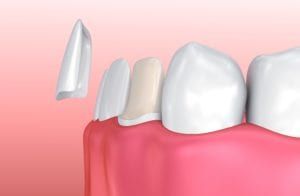
Veneers are customized, wafer-thin shells that are adhered to the front surface of your teeth. Despite their thinness, they are extremely durable and can withstand the force of chewing. They are most commonly made from porcelain, which is not only durable, but has a natural stain-resistant appearance as well.
When applying veneers, a small amount of tooth enamel must be removed so that the veneers can be securely placed without looking bulky. Only about less than a millimeter is removed to make ample room for the veneer. Once the tooth has been properly prepared for the veneer, a light-sensitive resin is applied between the tooth and the veneer and then hardened. The light-sensitive resin acts as a binding agent to secure the veneer to the tooth.
There are countless reasons that could indicate you need veneers. One primary reason is that you are simply not satisfied with your current smile. Specifically, if you are unhappy with your smile because your teeth are discolored, misshapen, uneven, gapped, or crooked then you may need veneers.
You may also need veneers if you have teeth that are chipped, cracked, or broken. Depending on the severity of the damage, veneers can be applied to the front surface of your teeth as a way of restoring the damaged tooth. Veneers can also be used on teeth that have become worn down as a result of teeth grinding or clenching.
Veneers are also ideal for individuals who have severely stained teeth that do not respond to traditional whitening treatments. Sometimes, certain medications can cause the teeth to become discolored and unresponsive to whitening treatments. In these cases, veneers are a great option to restore a whiter, brighter smile.
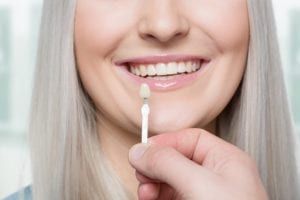

To receive the most benefits from veneers, you will want to be an ideal candidate. Ideal candidates have a better chance of successful, long-lasting treatment with veneers. To be considered an ideal candidate for veneers, you should be committed to your oral health and should practice good oral hygiene practices.You will also need to be in good oral health and have healthy gums prior to veneer placement. Any possible dental health issues must be treated and resolved before the placement of veneers.
To be an ideal candidate for veneers, you will need to consider your specific goals for cosmetic dental treatment to ensure that veneers are the best option for your aesthetic goals. As such, you should consider what specific aspects of your smile you want to fix, how much effort you want to put forth for treatment, your budget, and what your end goals are.
Overall, an experienced cosmetic dentist such as Dr. Sadati can help you determine if veneers are the best cosmetic dental option for your oral health needs and cosmetic goals.
If you are interested in determining whether you are a candidate for veneers, schedule a consultation with South Florida dentist, Dr. Sam S. Sadati of The Sadati Center for Aesthetic Dentistry today!
If you’re getting ready to visit your dentist for the first time, or it’s merely been so long that you’ve forgotten what a dental check-up is all about, then you may be wondering exactly what is involved in dental cleaning. Some people will talk about the tooth cleaning process like it’s a form of slow torture, but it’s likely that they haven’t sat in a dentist’s chair for a cleaning for some time. Tooth cleanings are a routine part of any dental check-up that is relatively quick and easy and will ensure that you can get a great start on the next six months of at-home oral health care.
Exams Are Always The First Step
Before your dentist or your hygienist can decide what the appropriate steps to take for your case are, they’re going to have to spend some time getting to know your mouth. During your exam, they’ll be checking you for gum diseases such as periodontitis and gingivitis, as well as looking for indications of conditions like grinding teeth and oral cancer. In some cases, they may have to speak to the dentist before going on with the cleaning process.
The Plaque And Tartar Get To Go First
Plaque, that sticky, filmy substance that builds up on our teeth when we neglect to brush is cleaned away from our teeth followed by the harder layer of tartar that builds up under it. The hygienist will clean the tartar away with a metal implement known as a scaler, specially designed to get into the hard to reach places and break away the build up. They’ll continue cleaning your teeth until all of the tartar has been removed.
A Professional Brushing Courtesy of Your Hygienist
Once all the tartar has been removed from your teeth, it’s time for them to move on to the next stage, which involves a high-grit toothpaste that is especially good at cleaning and polishing your teeth. The taste of the toothpaste you may find similar to what you use at home, but the texture is going to be decidedly grittier. This toothpaste is far more effective at cleaning your teeth but is only safe to be used by a professional once or twice a year.
Let The Experts Handle This Flossing, Do Yours At Home
No matter how meticulous you are about your flossing habits, it can be challenging to reach every area of your mouth. Thankfully when you come in for your six-month check-up, your hygienist is going to give you a flossing of their own, and you can be confident that every bit of debris will find its way out of your mouth by the time they’re done. Don’t be shocked if you see some blood; it’s normal when flossing areas that aren’t used to it.
Fluoride and a Rinse
This part of the process involves a high-pressure rinsing and the application of fluoride using a special gel in an application tray. Fluoride helps strengthen enamel and preserve your teeth against the ravages of plaque.
If you have any further questions about what goes into your tooth cleaning process, then contact Dr. Sam S Sadati at The Sadati Center For Aesthetic Dentistry in Wellington, FL. This clinic has been providing exceptional dental care for their patients and has restored and protected their smiles for years.
Believe it or not, the practice of using dental implants has gone back for millennia and has included the implantation of everything from artificial metal teeth, animal teeth, human teeth, and even seashell as ways to restore the missing teeth. While technology has come a long way, dental implants are still considered the best solution for patients who are looking to rebuild their smile and experience chewing and speaking in a natural fashion.
What Are Modern Implants Like?
With all this historical information about implants, it’s not surprising that you may be wondering exactly what the modern world has come up with for replacing missing teeth. Dental Implants start with the implantation of titanium mounts in your jawline, a procedure that requires a few months of recovery time to let them heal properly. At this point, a crown, bridge, full, or partial denture is mounted on these mounting points creating a smile with a natural appearance that is perfectly capable of doing everything your natural teeth could do.
I Have Medical Complications, Are Implants Appropriate For Me?
If you have conditions that identify you as medically compromised, then getting dental implants comes with some additional risks. In these patients, the implants may not survive as well, and it’s possible that peri-implant health and the complications associated with it could be a more significant concern. All that aside implants are still appropriate for most medically compromised patients, as the benefits on systemic health that comes with implants outweigh the potential risks. It’s important to discuss your desire to get dental implants with both your physician and your dentist to determine if your medical condition will affect your ability to get implants.
Is There Anything To Know before Getting Them?
The most important thing to know is that just as our natural teeth, implants need good professional and personal hygiene care to be maintained healthy and functional. While these teeth are durable and perfect for eating most foods, it’s important not to try to crack nutshells with them or eat exceptionally hard food (no crunching on hard candy, be patient!) as they can potentially break. Other than that dental implants will serve you as faithfully and completely as your natural teeth.
If you’ve been considering getting dental implants, or are merely wanting to speak to an expert about whether implants would be a good option for you, pick up the phone and give Dr. Sam S. Sadati at The Sadati Center for Aesthetic Dentistry in Wellington, FL. They bring an incredible amount of experience to cases involving patients from all over the world, many of whom have decided to use their services based on the excellent reputation they have for all areas of dentistry. Don’t let an awkward smile keep you from fearlessly participating in the life going on around you, call today and get a consultation with Dr. Sadati!